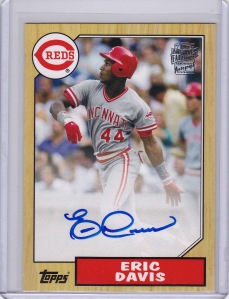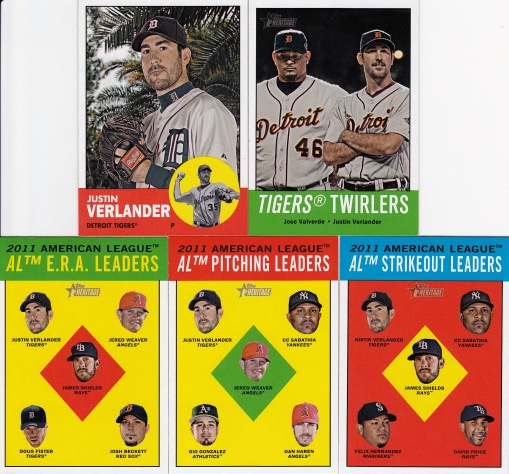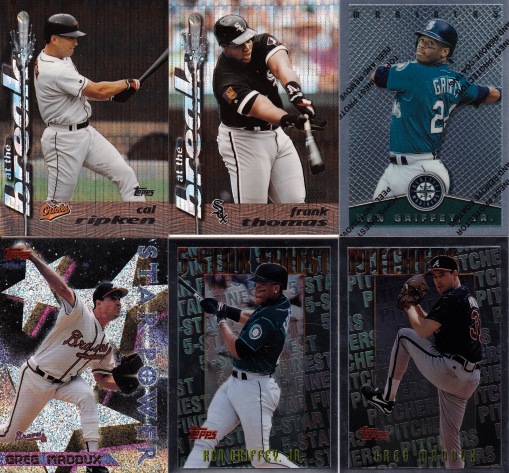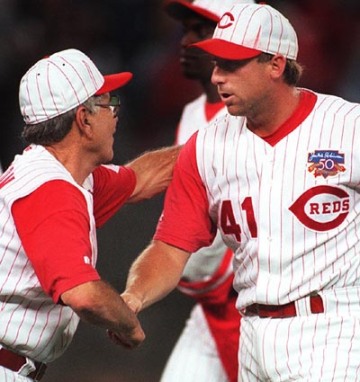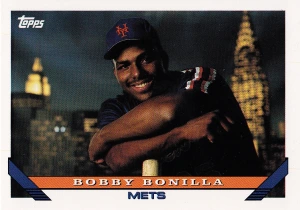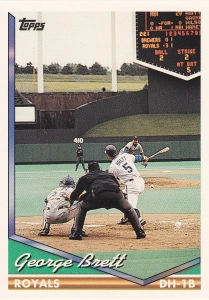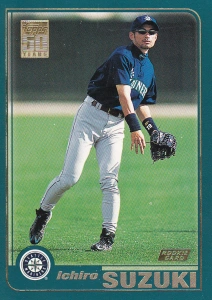 All-Star Game: AL over NL, 3-1 at Jacobs Field in Cleveland, OH (Sandy Alomar Jr., MVP)
All-Star Game: AL over NL, 3-1 at Jacobs Field in Cleveland, OH (Sandy Alomar Jr., MVP)
Home Run Derby: Tino Martinez 16 – beat Larry Walker 3-1 in the final (AL over NL, 32-29)
 ALDS: Cleveland Indians over New York Yankees, 3-2
ALDS: Cleveland Indians over New York Yankees, 3-2
Baltimore Orioles over Seattle Mariners, 3-1
NLDS: Florida Marlins over San Francisco Giants, 3-0
Atlanta Braves over Houston Astros, 3-0
ALCS: Indians over Orioles, 4-2
NLCS: Marlins over Braves, 4-2
World Series: Marlins over Indians, 4-3
**********
MVP: AL – Ken Griffey Jr., OF, Seattle Mariners (.304/56/147, .646 SLG, 125 R, GG)
NL – Larry Walker, OF, Colorado Rockies (.366/49/130, .452 OBP, .720 SLG, GG)
Cy Young: AL – Roger Clemens, SP, Toronto Blue Jays (21-7/2.05/292, 9 CG, 3 SHO, 264 IP)
NL – Pedro Martinez, SP, Montreal Expos (17-8/1.90/305, 13 CG, 4 SHO, 241.1 IP)
RoY: AL – Nomar Garciaparra, SS, Boston Red Sox (.306/30/98, 122 R, 209 H, 11 3B)
NL – Scott Rolen, 3B, Philadelphia Phillies (.283/21/92)
**********
MLB Amateur Draft:
Matt Anderson, P, DET (1st overall pick)
 JD Drew, OF, PHI (1st #2 – did not sign) – 2008 All-Star Game MVP
JD Drew, OF, PHI (1st #2 – did not sign) – 2008 All-Star Game MVP
Troy Glaus, 3B, ANA (1st #3) – 320 career HR, 2002 WS MVP
Vernon Wells, OF, TOR (1st #5) – 3x All-Star, 3x Gold Glove
Lance Berkman, 1B, HOU (1st #16) – 6x All-Star, 2011 NL Comeback PoY, 350+ HR, 1,200 + RBI
Chase Utley, SS, LAD (2nd #76)– 5x All-Star
Michael Young, SS, TOR (5th #149) – 7x All-Star, 1x Gold Glove, 6x 200 Hits, 2005 AL Batting Champ, 2,100+ career H, 400+ career 2B
 Antwaan Randle-El, OF, CHC (14th #424) – 2005 NFL All-Pro, first NCAA player with 40 rushing & passing TD, played varsity football, baseball & basketball at Indiana
Antwaan Randle-El, OF, CHC (14th #424) – 2005 NFL All-Pro, first NCAA player with 40 rushing & passing TD, played varsity football, baseball & basketball at Indiana
David Eckstein, 2B, BOS (19th #581) – 2006 World Series MVP, 2x All-Star
**********

Wells, Eagles
Hall of Fame: Phil Niekro, SP, Atlanta Braves (4th ballot)
Nellie Fox, 2B, Chicago White Sox (VC)
Tommy LaSorda, MGR, Los Angeles Dodgers (VC)
Willie Wells, SS, St. Louis Stars, Newark Eagles (VC)
**********
Batting Leaders:
Avg. (AL) Frank Thomas CHW .347, (NL) Tony Gwynn SDP .372
HR (AL) Griffey Jr. SEA 56, (NL) Walker COL 49
(Note – Mark McGwire actually led the majors with 58 homers, though he was traded from Oakland to St. Louis mid-season)
RBI (AL) Griffey Jr. SEA 147, (NL) Galarraga COL 140
R (AL) Griffey Jr. SEA 125, (NL) Craig Biggio HOU 146
SB (AL) Brian L. Hunter DET 74, (NL) Tony Womack PIT 60
H (AL) Garciaparra BOS 209, (NL) Gwynn SDP 220
Pitching Leaders:
W (AL) Clemens TOR 21, (NL) Denny Neagle ATL 20
ERA (AL) Clemens TOR 2.05, (NL) Martinez MON 1.90
K (AL) Clemens TOR 292, (NL) Curt Schilling PHI 319
SV (AL) Randy Myers BAL 45, (NL) Jeff Shaw CIN 42
**********
Trends and Stats:
6 players above .330 AVG, 3 above .350 AVG
30 players above 30 HR, 12 above 40 HR, 2 above 50 HR
35 players above 100 RBI, 11 above 120 RBI
7 player above 50 SB
4 players above 200 H
4 pitchers above 20 W
10 pitchers above 200 K, 4 above 250 K, 2 above 300 K
13 pitchers below 3.00 ERA, 4 below 2.50 ERA, 1 below 2.00 ERA
5 pitchers above 250 IP
3 pitchers above 40 SV
**********
Tomorrow I’ll post my standard All-Star selections and compare to the silver slugger winners for the year.
